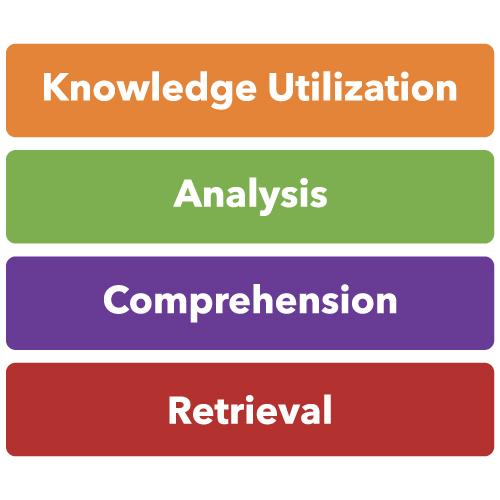
“With more than thirty years of experience as a teacher, school leader, and district administrator, I can unequivocally say this: a clear vision for instruction and a framework that defines effective teaching are essential to student achievement, teacher growth and retention, and continuous school improvement.”
– Lorah Neville, Executive Director of the Marzano Evaluation Center and former Superintendent
Identifying the teaching practices that get the best results for students and developing more effective teachers may be the most important goals of any school or district leader, since these foundations influence so many other priorities.
Yet determining what is working and pinpointing where teaching can become more effective is challenging. That’s where the Marzano elements can provide a clear framework.
What Are the Marzano Elements?
The Marzano elements define the essential behaviors of effective teaching, organized into domains of expertise as part of the Focused Teacher Evaluation Model (FTEM).
The framework drives progress in multiple key priority areas, including:
- Student achievement: The Marzano elements guide teachers to ensure all students engage with rigorous learning experiences that lead to higher academic outcomes.
- Teacher growth and retention: By defining what effective teaching looks like, the Marzano elements help leaders provide clear feedback and targeted support. Teachers grow professionally and feel valued, which increases retention.
- Continuous school improvement: The coherent framework of the Marzano elements provides a shared language and vision that helps schools stay aligned and continuously improve.
This article breaks down the building blocks of effective teaching. You will deepen your mastery of the Marzano elements so you can lead your classroom, school, or district to greater success.
Why the Marzano Elements Work
The reason the Marzano elements work is that they are clear, purposeful, and well-organized. Each element is supported by a practical protocol and designed to make the impact on student learning visible rather than only measuring teacher actions.
How Many Marzano Elements Are There and What Are the Four Domains of the Marzano Framework?
The original Marzano Teacher Evaluation Model includes 60 elements, and many other evaluation models include dozens of vague indicators across multiple domains.
Unlike these models, the Focused Teacher Evaluation Mode (FTEM) streamlines the process into just 23 elements across four domains of teacher practice:
- Standards-Based Planning (3 elements)
- Standards-Based Instruction (10 elements)
- Conditions for Learning (7 elements)
- Professional Responsibilities (3 elements)
Of these, 18 elements are directly tied to student achievement and progress toward standards-based learning targets.
What Makes Each Marzano Element Powerful?
Each element is supported by a protocol that includes:
- A Focus Statement (the teacher competency)
- A Desired Effect (the intended impact on students)
- A Developmental Scale (to measure growth and effectiveness)
Simply put, when teachers demonstrate the focus statement, students experience the desired effect. This is FTEM’s theory of action, making the model a clear, research-based roadmap from teaching practice to student learning.
Example of a Marzano Element Focus Statement and Desired Effect
Marzano Element: Previewing New Content
Domain: Standards-Based Instruction
Focus Statement: “Teacher engages students in previewing activities that require students to access prior knowledge as it relates to the new content.”
Desired Effect: “Evidence (formative data) demonstrates that students make a link from what they know to what is about to be learned.”
See more details in The Marzano Focused Teacher Evaluation report and explore the model.
The Research Behind the Marzano Elements and Focused Teacher Evaluation Model
The Marzano Elements and Focused Teacher Evaluation Model draw from the concepts and research articulated in Robert Marzano’s The Art and Science of Teaching (2007), and from his earlier research, including:
- What Works in Schools (Marzano, 2003)
- Classroom Instruction That Works (Marzano, Pickering, & Pollock, 2001)
- Classroom Management That Works (Marzano, Pickering, & Marzano, 2003)
- Classroom Assessment and Grading That Work (Marzano, 2006)
The Marzano elements and model also build on the findings outlined in John Hattie’s Visible Learning (2008), which synthesized 800 meta-analyses related to student achievement.
Taken together, these works represent the most comprehensive evidence-based research ever into what practices have the greatest impact on student learning.
Applied Research Center Validation
Between 2012-2016, the Applied Research Center studied the correlation between scores from the Marzano Teacher Evaluation Model and student growth on state assessments across three years, utilizing the largest dataset available:
- Over 1.48 million scores for instructional Marzano elements collected during evaluative classroom observations
- Over 248,000 evaluative observations
- Over 58,000 teachers
Key findings included (Basileo & Toth, 2019):
- All elements in the Marzano model have a small positive significant correlation to student learning gains
- When examining teacher attributes including advanced degrees, the teacher observation score was the largest predictor in the study of student growth on state assessments
Most recently, the Marzano Focused Teacher Evaluation Model (FTEM) was validated in Oklahoma, showing a strong correlation with improved achievement in mathematics and English Language Arts (in press, Basileo et al., 2025).
This means that as FTEM scores went up, ELA and math scores also went up, with a 99.9% confidence level.
No other evaluation model has empirically tested whether its observation-based elements create a measure of teacher effectiveness that predicts schoolwide proficiency in a state. None have achieved correlations as strong as those observed here.
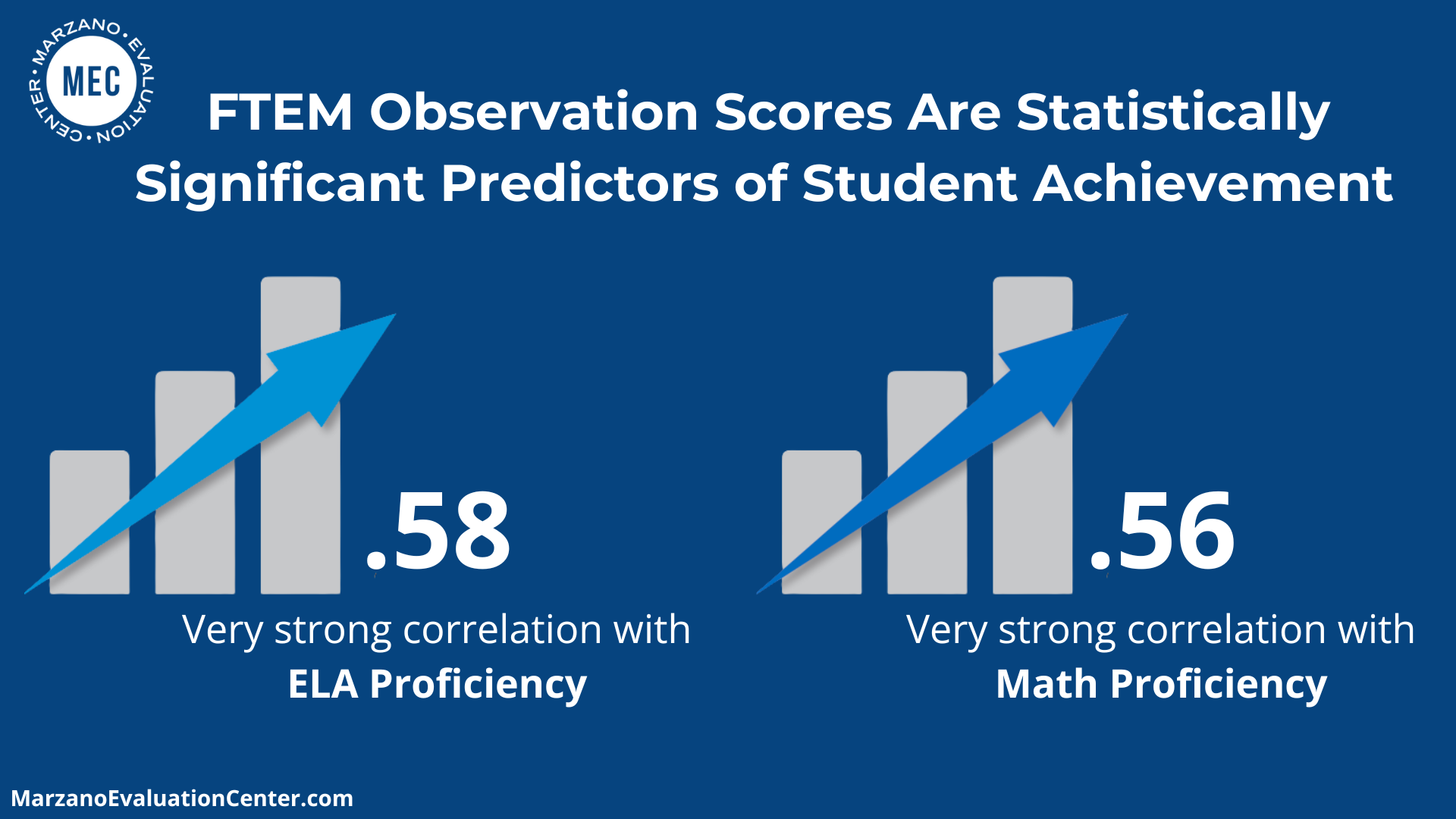
Keeping the Focus on What Matters with the Marzano Elements
The research behind the Focused Teacher Evaluation Model (FTEM) makes clear that student growth is dependent on effective instruction.
Student achievement improves only when effective teaching happens in Tier 1 core instruction, the daily lessons where students spend most of their time. You cannot “intervene your way” to higher achievement. FTEM keeps the focus where it matters most: student evidence of learning in every lesson, every day.
Some may wonder if 23 elements are too many. But educators using the model find the framework realistic and effective in daily practice.
“I love using FTEM because it gives me very specific examples of how I can help my students succeed in the classroom. It gives me measurable ways to check myself and to check my students and it gives me great strategies to utilize in the classroom to get my students where they need to be.”
– Emily Freck, Teacher, Brook Park Elementary, MSD of Lawrence Township, Indianapolis, IN
Consider this: a kindergartener experiences 180 days of instruction across nine content areas with dozens of standards to master. Compared to the complexity of what students are asked to learn, 23 research-based elements are fully manageable for teachers and leaders alike.
To make the framework practical, the 23 Marzano elements are organized into four domains, which we call the building blocks of effective teaching. Each domain represents a critical area of teacher responsibility. Together, these building blocks form a coherent framework for improving instruction across classrooms and schools.
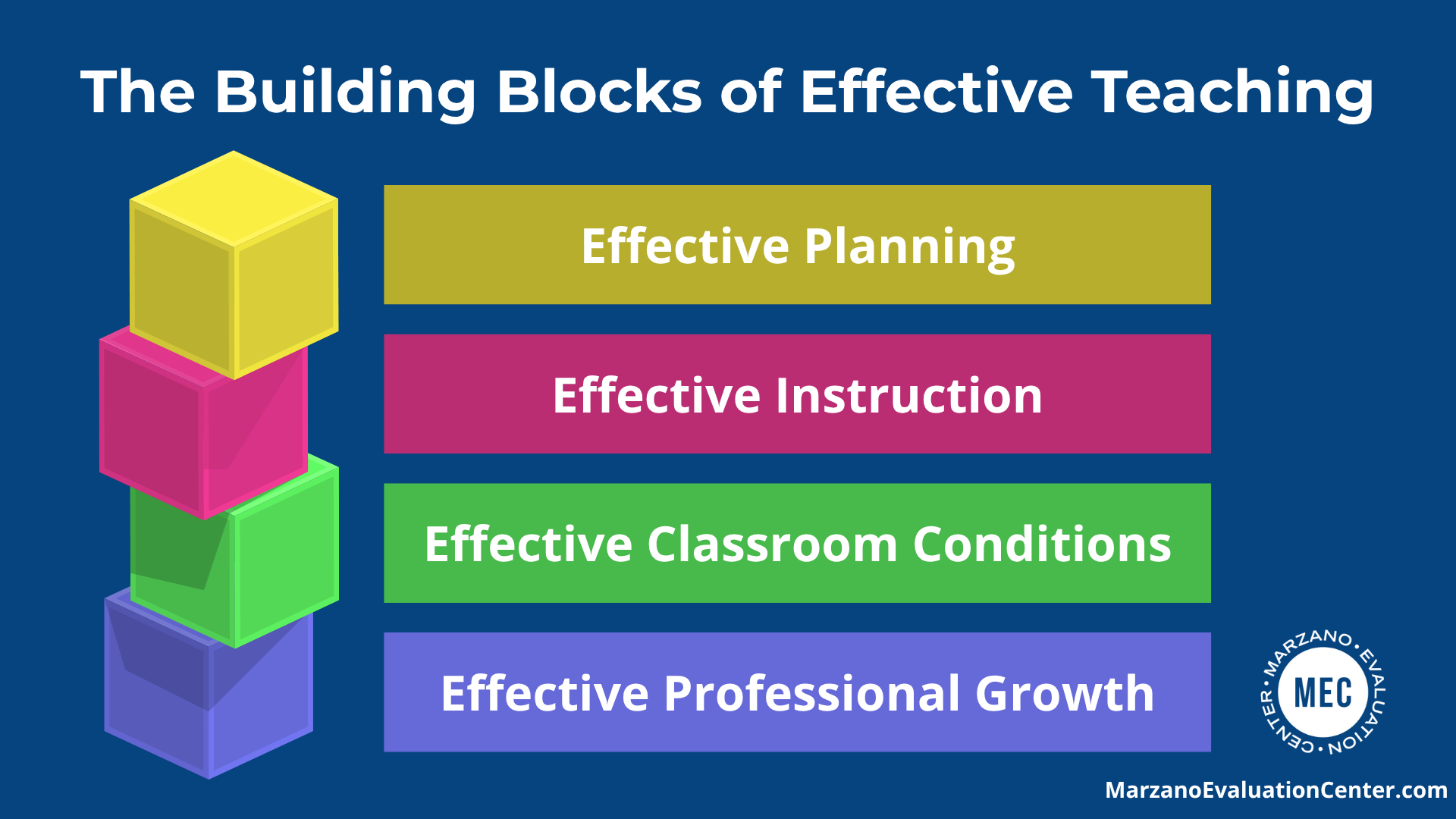
In the sections that follow, we’ll take a closer look at each of these four building blocks to see how the Marzano elements strengthen teacher practice, increase student learning, and support districtwide success.
Building Block 1: Effective Planning
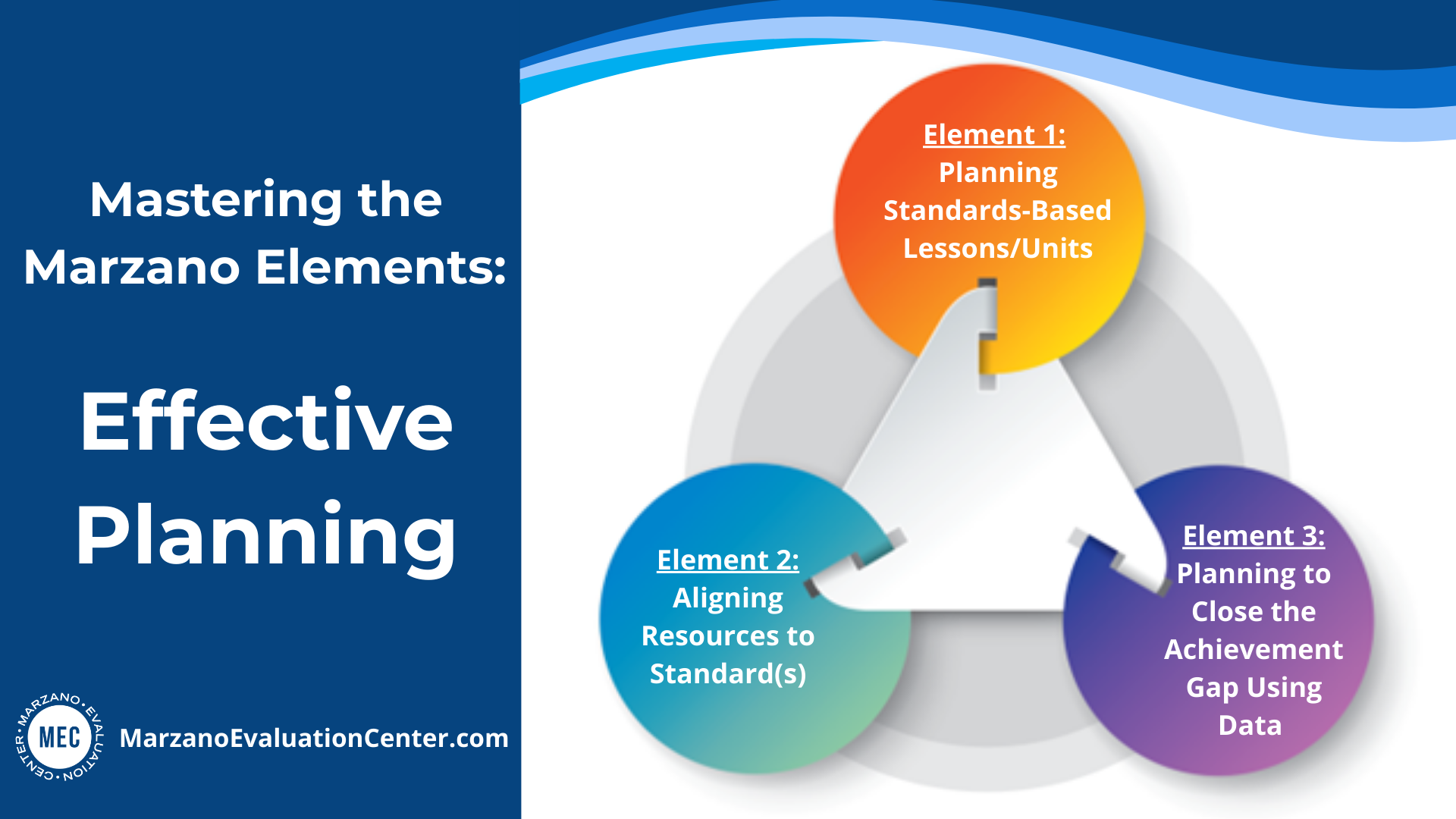
The first Marzano element, Planning Standards-Based Lesson/Units sets the stage for instructional success. Knowing your standards is an essential ingredient to effective teaching. There is no shortcut here. During planning conferences, teachers and evaluators collaborate on lesson design to ensure alignment to standards, cognitive complexity, and accurate content. Effective teaching doesn’t happen by accident; it happens by design.
“Effective teaching doesn’t happen by accident; it happens by design.”
Target-task misalignment is the crux of low performance. We aren’t preparing students cognitively for the level at which they are going to be assessed.
For example, a lesson might target higher-level thinking—“compare two texts and explain how the authors’ purposes differ using evidence”—but the actual task students complete is a simple summary. The target is analysis, but the task is comprehension. Misalignments like these prevent students from developing the skills needed for success on high-stakes assessments.
In many states, test specifications for grades 3–11 place more than 80% of their emphasis on comprehension and analysis. When students practice at lower levels of a standard than the level at which it will be assessed, we unintentionally set students up for academic failure. To ensure success, student tasks must align not only to the content of the standards but also to the cognitive level at which students will be expected to demonstrate mastery.
Marzano Elements 2 and 3 further strengthen the Standards-Based Planning domain:
- Element 2 guides teachers to connect aligned tasks to both traditional and digital resources that match the standard and the appropriate taxonomy level.
- Element 3 ensures planning includes measures that track all students’ progress, helping close the achievement gap, which is critical for many schools.
Together with Element 1 (Planning Standards-Based Lessons/Units), these three elements form the first building block of effective teaching, ensuring every lesson begins with purposeful planning.
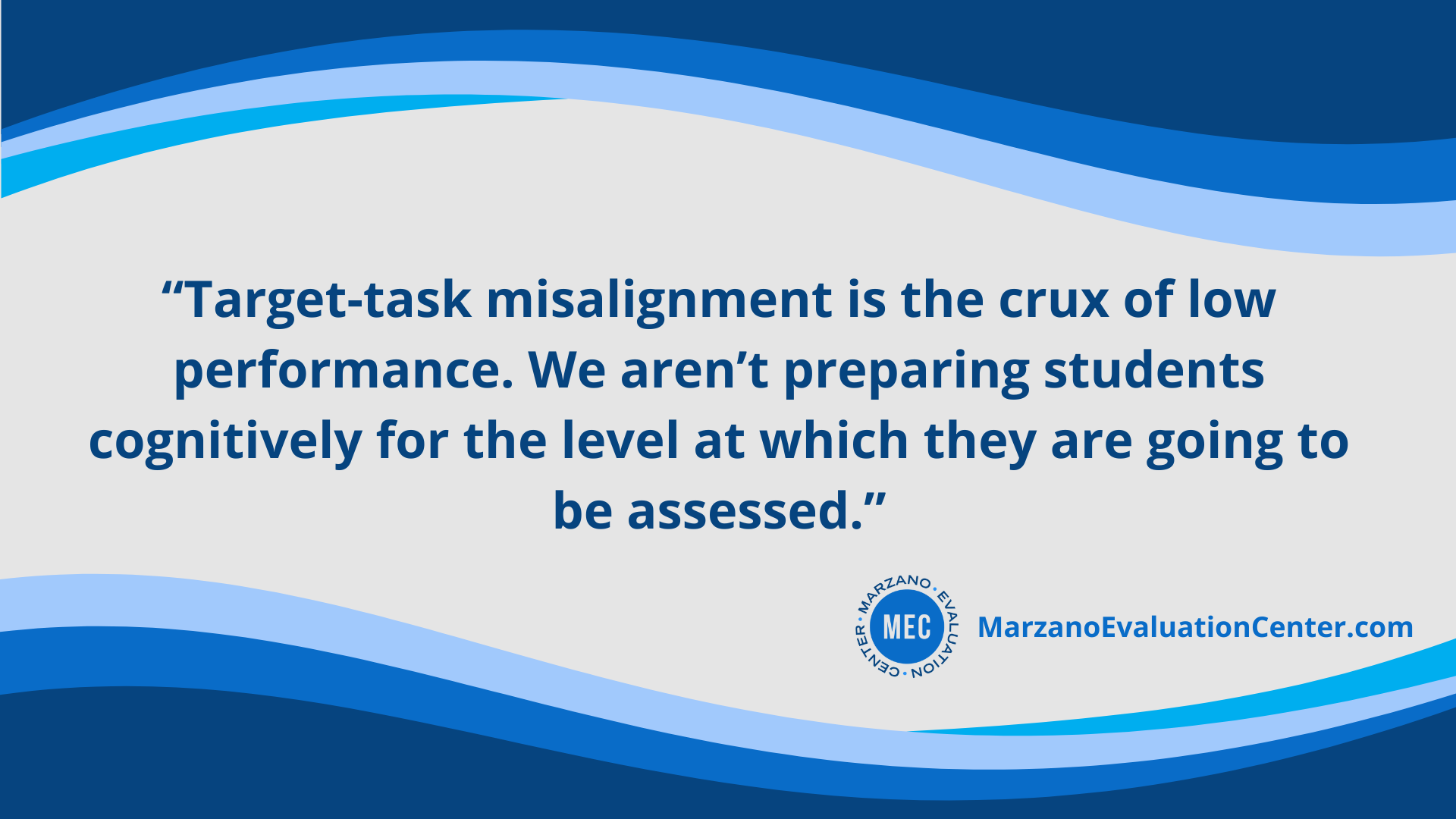
Building Block 2: Effective Instruction
Instructional misalignment is one of the most common problems in classrooms. The way to eliminate this is by requiring alignment between learning targets, tasks, and cognitive demand.
Every lesson must identify critical content (a learning target from grade-level standards), and then the teacher selects the appropriate strategies from the 10 instructional Marzano elements listed below.
An important feature of the Standards-Based Instruction Domain is the intentional design of strategies that align with different levels of cognitive demand:
- Building foundational knowledge
- Deepening understanding
- Extending student thinking toward analysis
- Knowledge utilization through complex problem-solving, investigation, and decision-making
| Marzano Elements in the Standards-Based Instruction Domain | Cognitive Demand Level |
| Identifying Critical Content | Every Lesson |
| Previewing New Content | Building Foundational Knowledge |
| Processing New Content | |
| Using Questions to Help Students Elaborate on Content | |
| Reviewing Content | Practicing and Deepening |
| Helping Students Practice Skills, Strategies, and Processes | |
| Helping Students Examine Similarities and Differences | |
| Helping Students Examine Their Reasoning | Extending Thinking/Analysis |
| Helping Students Revise Their Knowledge | |
| Helping Students Engage in Cognitively Complex Tasks | Knowledge Utilization |
Notice how many of the Marzano elements within the building block of effective instruction begin with “Helping Students….” This word choice is intentional. In effective classrooms, teachers help students to do the intellectual heavy lifting and design tasks that engage students in productive struggle.
Subscribe for monthly insights about evaluation that leads to measurable growth.
Building Block 3: Effective Classroom Conditions
Strong instruction requires strong conditions for learning. The seven elements of the Conditions for Learning domain form the third building block of effective teaching, focusing on how classroom climate supports student growth.
These seven Marzano elements can be further grouped into themes around classroom conditions:
- Monitoring Student Progress and Feedback
- Rigorous Learning
- Classroom Environment
| Monitoring Student Progress and Feedback |
| Using Formative Assessment to Track Progress |
| Providing Feedback and Celebrating Progress |
Formative assessment is often misunderstood as something teachers do for students. The Focused Teacher Evaluation Model challenges educators to make formative assessment something students do for themselves.
This aligns with decades of research from Rick Stiggins (2019), who highlights that students are the primary beneficiaries of formative assessment.
When students track their progress and see growth, efficacy builds and achievement follows. How do we empower students to take ownership of their learning? By making sure that students are not passive participants (Stiggins, 2019).
Effective teaching practices give students an active role and responsibilities. Teachers also play a critical role in providing feedback to students and celebrating their progress, creating a classroom culture that values growth and improvement.
| Rigorous Learning |
| Organizing Students to Interact with Content |
| Using Engagement Strategies |
We need students to work harder than the teachers! That’s why classroom conditions for rigorous learning are so important—when students’ brains are working hard, they are developing knowledge and skills.
Structured opportunities for collaboration are some of the most effective engagement strategies, allowing students to move from passive participants to active learners.
These two Marzano elements create truly rigorous learning experiences. Teachers must plan for rigor (building block 1), but equally important is a classroom culture where students are the ones expected to do the intellectual heavy lifting during the lesson.
| Classroom Environment |
| Establishing and Acknowledging Adherence to Rules and Procedures |
| Establishing and Maintaining Effective Relationships in Student-Centered Classrooms |
| Communicating High Expectations for Each Student to Close the Achievement Gap |
When these three Marzano elements related to the classroom environment work together, they create a safe, supportive, and structured learning environment. The classroom environment should foster student confidence, academic growth, and a strong sense of community.
When students know their teacher believes in their potential, student motivation and persistence often increase as a result. Research shows that students who take responsibility for their learning, feel competent as learners, and feel valued as part of a learning community (Gottfried et al., 2008) also:
- Feel good about themselves
- Have a positive attitude about their education
- Persist in the face of challenges
- Perform well academically
Having strong conditions for learning is truly critical to student outcomes, forming the third building block of effective teaching.
Building Block 4: Effective Professional Growth
The last piece to the puzzle is ensuring a strong foundation built on teachers as professionals and leaders. The Domain of Professional Responsibilities consists of three Marzano elements:
- Adhering to School and District Policies and Procedures
- Maintaining Expertise in Content and Pedagogy
- Promoting Teacher Leadership and Collaboration
These three elements highlight that teaching is not just about delivering lessons to students; it’s about cultivating teacher leadership and professionalism.
The third element is often overlooked but essential. If you don’t want to be the leader with a line outside your door, you must empower and grow others to share the leadership. By empowering teachers with the tools to lead, collaborate, and share responsibility for student success, schools become true learning organizations.
As Tucker (2019) notes, teacher leadership has a profound impact on school culture. When teachers take ownership of instructional practices, mentoring, and collaborative problem-solving, they not only improve their own classrooms but also help transform the entire school. The result is a learning community of growth, innovation, and success for teachers and students alike.
Putting the Marzano Elements into Action
Mastering the Marzano elements is about more than improving teacher evaluations. It’s about clarity, reliability, and impact leading to teacher growth and higher student achievement.
Too often, districts try to “fix” achievement gaps after the fact, but real progress begins in focusing on the foundational building blocks of Tier 1 instruction. By investing in your teachers and their teaching practices, you invest in your students and your future.
This investment starts with understanding the 23 Marzano elements and how they are organized for effective teaching:
| Building Block | Domain | Number of Marzano Elements | Focus |
| 1 | Standards-Based Planning | 3 | Purposeful planning aligned to the standards |
| 2 | Standards-Based Instruction | 10 | Student engagement and evidence of learning |
| 3 | Conditions for Learning | 7 | Supportive, rigorous classroom culture |
| 4 | Professional Responsibilities | 3 | Teacher growth, leadership, and professionalism |
The Focused Teacher Evaluation Model’s practical framework puts the 23 Marzano elements into action to help districts escape from the trap of continuing to do what they’ve always done and getting the results they’ve always gotten.
Contact the Marzano Evaluation Center Today
Explore how the Marzano elements and Focused Teacher Evaluation Model can help your district invest in teachers, close gaps, and drive student success.
References
Basileo, L. D., Lyons, M.E, Toth, R. J., Marzano, L., Neville (2025). Reviving Teacher Evaluation as a Tool for Feedback: A Latent Variable Analysis of Marzano Teacher Effectiveness and School Achievement. In Press, Submitted to AERA Open, July 30, 2025.
Gottfried, A. E., Gottfried, A. W., Morris, P. E., & Cook, C. R. (2008). Low academic intrinsic motivation as a risk factor for adverse educational outcomes. In C. Hudley & A. E. Gottfried (Eds.), Academic motivation and the culture of school in childhood and adolescence (pp. 36–70). Oxford University Press. https://doi.org/10.1093/acprof:oso/9780195326819.003.0003
Hattie, J. (2008). Visible learning. Routledge.
Marzano, R.J., Pickering, D., Pollock, J.E. (2001) Classroom instruction that works: Research-based strategies for increasing student achievement. ASCD.
Marzano, R.J. (2003). What works in schools: Translating research into action. ASCD.
Marzano, R.J., Marzano, J.S., Pickering, D.J. (2003). Classroom management that works: Research-based strategies for every teacher. ASCD.
Marzano, R.J. (2006). Classroom assessment & grading that work. ASCD.
Marzano, R.J. (2007) The art and science of teaching. ASCD.
Marzano, R. J., & Kendall, J. S. (2007). The new taxonomy of educational objectives (2nd ed.). Corwin Press.
Stiggins, R. (2019). Classroom assessment for student learning: Doing it right – using it well. (3rd edition). Pearson. Tucker, M. (2019) Leading high-performance school systems: Lessons from the world’s best. ASCD
Tucker, M. (2019) Leading high-performance school systems: Lessons from the world’s best. ASCD
Subscribe for monthly insights about evaluation that leads to measurable growth.
About Marzano Evaluation Center
The Marzano Evaluation Center is the foremost destination to inquire about and receive access to the world-renowned Marzano Focused Teacher Evaluation Model (FTEM). The Focused Teacher Evaluation model, along with our school leader, district leader, and support staff evaluation models culminate in our systemwide approach to evaluation. This comprehensive approach has allowed us to collaborate with school districts to improve their educational outcomes by aiding professionals in attaining useful feedback on classroom and personal performance.

